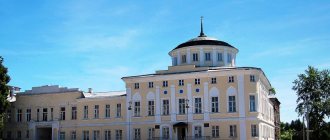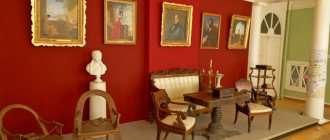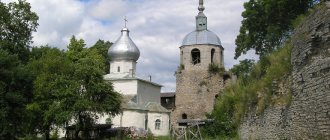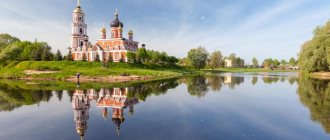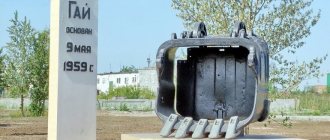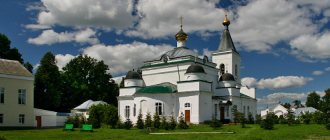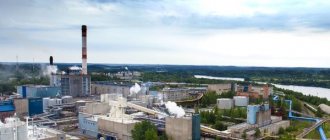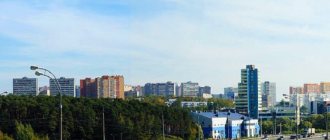It should not be confused with the village of Kasimov station.
This term has other meanings, see Kasimov (meanings).
| City | |
| Kasimov | |
| Gorodets-Meshchersky | |
| Flag | Coat of arms |
Moscow
Ryazan
Kasimov
Media files on Wikimedia CommonsKasimov
(Tat. Khankirmәn, Kasym, until 1376 -
Gorodets Meshchersky
, until 1471 -
New Lower City
) - a city in Russia, the administrative center of the Kasimovsky district of the Ryazan region, which is not part of, being a city of regional significance, it forms a municipal formation - urban district
city of Kasimov
[2].
Located on the left bank of the Oka River. The estimated population as of January 1, 2022 is 29,700 people[3].
Geography
The city of Kasimov is located in the center of the East European Plain in the northeast of the Ryazan region, 165 km from Ryazan by road (111 km in a straight line), 262 km from Moscow, at 54°56′ north latitude and 41°21′ east longitude . The border with the Vladimir and Nizhny Novgorod regions is about 30 km, but you can get to the territory of the second from Kasimov only through Ermish or Murom, since there are no crossings across the Oka in this area.
The city stands on the left bank of the Oka on high hills, cut by ravines. The river bends in this place in the form of a large loop and is about 380 meters wide. Near the city there is the Oka Biosphere Reserve.
Kasimov is the extreme eastern point of the Meshchera Lowland; On the opposite bank of the Oka, another geographical space begins - the Oka-Don Plain.
Climate, minerals, water resources, soils, forests
The climate of the region is temperate continental, average annual precipitation is 725.3 mm, the average temperature in July is + 19.9°, above normal by 1.1°, the absolute maximum is + 31.9°, the average temperature in January is 8.3°, above by 3.2°, the absolute minimum is 8.3°.
Minerals. The oldest rocks discovered in the area are limestones, the development of which is carried out in two quarries - Kasimovsky and Akishinsky. When processed, valuable building material is obtained from them, and at the limestone flour plant, limestone flour is obtained for agricultural needs. There are also reserves of clay and sand.
Water resources. Length of the river The Oka River within the region is about 150 km long, the largest tributaries flowing into it are Gus, Tashenka, Unzha.
The soils in the area are dominated by gray forest and soddy-podzolic soils. Of the total soil composition, 23% are strongly acidic, 38% are moderately acidic, and 39% are slightly acidic.
Forests occupy half of the region's territory. On the territory of the Kasimovsky district there are 2 reserves with a total area of 4537 hectares, 11 natural monuments with a total area of 1144 hectares.
Story
Foundation of the city
| This section may contain original research. Add links to sources, otherwise it may be deleted. More information may be on the talk page. (May 25, 2012) |
| The section lacks links to sources. Information must be verifiable or it may be deleted. You can edit the article to add links to authoritative sources. This mark is set June 1, 2022 . |
The foundation of the city dates back to 1152[4], when Gorodets Meshchersky
(located slightly downstream of the Oka from modern Kasimov, at the confluence of the Babenka River with the Oka).
By order of Prince Yuri Dolgoruky, Gorodets Meshchersky was turned into a border fortress of the Rostov-Suzdal (Suzdal Principality). In 1376, the city was completely burned and devastated as a result of the Mongol raid [ source not specified 253 days
], but soon a new city arose not far from the previous location, which until 1471 was called
the New Lower City
.
The initial localization of Gorodets Meshchersky is expected in the area of Stary Posad (Ulanova Gora). The transfer of the city to its modern location was carried out during the reign of Shah Ali Khan, that is, no earlier than the mid-second half of the 16th century[5]. Russians and long-time inhabitants of these places lived in it - Meshchera, Mordovians, Murom [ source not specified 470 days
].
Kasimov Khanate
Main article: Kingdom of Kasimov
In the 15th century, an unexpected and very significant change occurred in the life of Gorodets. In the struggle for the Moscow throne, Grand Duke Vasily the Dark received great help [ what?
] provided by the Tatar princes Kasim and Yakub. In 1446, they left Kazan for Rus', fleeing the persecution of their brother Makhmutek, who seized power. For loyalty and important services, Prince Vasily granted Kasim Nizova Gorodets. This was in 1452. Thus, by princely decree, the Kasimov Khanate arose in the depths of the Meshchera forests, which existed from 1452 to 1681. The kingdom included the territory of the districts of the future Ryazan and Tambov provinces (Kasimovsky, Shatsky, Elatomsky, Temnikovsky)[6].
As part of the Russian state
Kasimov in an engraving by Adam Olearius, 1630s
After Ivan the Terrible conquered Kazan in 1552, the last ruler of the Kazan Khanate, Syuyumbike, was exiled to Kasimov, who died in this city a few years later.
In 1681, with the death of the last owner of Kasimov, Fatima Sultan, the Kasimov kingdom (Khanate) ceased to exist and was annexed to the palace volosts[7]. From the period of the Kasimov kingdom, several interesting buildings have been preserved in the city: a minaret from the time of Tsarevich Kasim, a mosque, two mausoleums (tekiyas), the Tatar kings were buried in the mausoleums.
In the 17th century, Kasimov was divided into 3 parts: the inheritance of the Kasimov khans and beks ( Tatarskaya Sloboda
and
Stary Posad
);
Yamskaya Sloboda
(was directly subordinate to Moscow), the rest of the city (including
Marfina Sloboda
) was governed by the Kasimov voivode.
In 1719, according to the decree of Peter I “On the organization of provinces and on the appointment of their rulers,” the Pereyaslav-Ryazan province was formed as part of the Moscow province.
County town
In 1773, Kasimov became a district town - the center of the Kasimov district of the Ryazan governorship. After the death of Catherine II in 1796, Paul I restored the division of the country into provinces. On December 12, 1796, the governorship was transformed into the Ryazan province[8].
Kasimovsky district on the map of the Ryazan governorship. 1792
By the time of the Peasant Reform in 1861, there were 42 noble landowners in the district. Some of them were the largest land magnates, owning several tens of thousands of dessiatines. More than 80% of all peasants in the county were dependent on large and small landowners.
In the first half of the 19th century, industry began to develop in the city, which in some cases was based on local crafts, widely developed in the county. At the end of the 19th century, Kasimov became a fairly large commercial and industrial city. At that time (according to the 1897 census) 13,500 people lived in it. The city had 40 taverns [ source not specified 3493 days
], a hospital with 50 beds, 15 churches and three secondary educational institutions.
In 1910 the population was 17 thousand people.
Soviet period
At the beginning of November 1918, an uprising took place in the city, organized by local peasants who were forcibly mobilized into the Red Army[9]. After the suppression of the uprising, the Bolsheviks shot up to 150 people.
In 1937, the Ryazan region was formed, which included the Kasimovsky district. On February 11, 1944, Kasimov received the status of a city of regional subordination[10].
In 1991, an enterprise for processing precious metals, the Prioksky Non-Ferrous Metals Plant, was opened in Kasimov; in the same year it produced its first melt. At the same time, a criminal war began in the city for control over thefts from the plant, in which 50 people became victims.
Culture, education, social life
Kasimovsky district has the largest network of cultural institutions in the Ryazan region.
Operating in the area:
— Municipal cultural institution “Intersettlement Organizational and Methodological Center of the Kasimovsky District of the Ryazan Region” (“MUK MOMC”) with separate structural units in the form of 26 recreation centers and rural clubs (14 rural recreation centers and 12 rural clubs), 3 auto clubs;
— Municipal cultural institution Gusevsky Club Association (“MUK GKO”) with a separate structural unit Gusevsky Auto Club;
— Municipal cultural institution “Central District Inter-Settlement Library of the Kasimovsky Municipal District” (“CRMB of the Kasimovsky Municipal District”) with 39 separate structural divisions;
— Municipal cultural institution Elatom Museum of Local Lore (“MUK EKM”);
— Municipal educational institution of additional education for children “Elatomsk Children’s Music School” (MOU DOD “Elatomsk Children’s Music School”) with 2 branches in the village. Gus-Zhelezny and Krutoyarsky village.
District cultural institutions held 4,715 events, which were attended by 151.3 thousand people. In 2012, 62.8 million rubles were spent, including 11.8 million rubles for strengthening the material and technical base. (repair work took place in 7 institutions).
There are 98 permanent amateur art groups and 220 club groups in the region. There are 8 folk groups, among them: Folk song ensemble of the Ryazan region "People's holiday" (Municipal cultural institution Gusevskoe club association), Exemplary folk song ensemble of the Ryazan region "Gusachok", People's theater of small forms "Istoki", Folk choir of the Ryazan region of the Dmitrievsky SDK , Folk song ensemble of the Ryazan region “Ivushka” of the Lashmansky SDK, Folk song ensemble of the Ryazan region “Tenderness” of the Krutoyarsky cultural center, Folk song ensemble of the Ryazan region “Sudarushki” of the Kasimovsky quarry SDK, Folk theater of the Ryazan region of the Elatom House of Culture. Leading creative groups represented the Kasimovsky district 9 times at various competitions and festivals, including the II International Festival “Cossack Village Moscow”, the festival-fair “Cossack Circle” of the East Kazakhstan region “Central Cossack Army” in Moscow. At the IV Regional Assembly of choral, ensemble and vocal music “We glorify the daring, courage, exploits of heroes,” the Gusev group “People's Holiday” became the winner and received a 1st degree Laureate Diploma.
The book collection of the central regional library is about 235.7 thousand copies, the number of readers is more than 19.9 thousand people. District libraries held 959 events.
In the Municipal Educational Institution of Children's Education "Elatomsk Children's Music School" with two branches in the village. Gus-Zhelezny and Krutoyarsky settlement have 190 students.
The Elatom Local History Museum conducts a large number of excursion and exhibition activities, cultural and educational work among the population. Museum and theater events are held with the participation of members of the “Friends of the Museum” club, meetings with descendants of noble fellow countrymen. The main museum fund is 2221 units, auxiliary – 1358 units. To attract a large number of visitors, interesting, diverse tourist excursions around Elatma and the surrounding area have been developed.
The Kasimov poets made a significant contribution to the poetic life of the Ryazan region. More than 40 poets and writers, of which 9 members of the Russian Writers' Union come from the Kasimovsky district and the city. The names of four are associated with Syntul, a wonderful corner of the Kasimov land. These are Valery Avdeev, Sergey Pravdolyubov, Zoya Likhacheva and Boris Shishaev.
— Boris Mikhailovich Shishaev is recognized as one of the outstanding writers of our time. He combined a literary gift with the talent of a thinker and philosopher.
Understanding the importance of spiritual and moral communication between people, Boris Mikhailovich Shishaev regularly took part in creative meetings with readers. But their scope became narrow, and in 2006 the regional literary festival “Boris Shishaev Gathers Friends” took place for the first time.
In June 2009, the idea arose to expand the holiday and transform it into the Ryazan Poetry Festival, where the main characters were members of the Ryazan Regional Writers' Organization and representatives of amateur literary associations from all over the region.
As part of the festival, a competition “Poet of the Year” is held among non-professional poets. The results of the competition are announced at the festival. The winners are awarded diplomas and memorable prizes.
— Valery Nikolaevich Avdeev was born and spent most of his life in the village of Syntul. And he created the best works in his small homeland, which he loved endlessly.
Valery Nikolaevich is recognized by the literary community as a poet of original talent and high soul, who sincerely believes in the power of goodness, in the power of his native land. He is a bright representative of the Kasimov poetic school, and although his poetic heritage is small, only 4 collections, in 2001 Valery Nikolaevich was awarded the international Platonov Prize.
Kasimovites honor the memory of their fellow countryman Valery Avdeev and for 7 years now, in the month of July, friends and admirers of his talent have been coming to the village of Syntul for the Avdeev Readings.
— The talented and original singer of Kasimov’s Meshchera, Evgeny Fedorovich Markin, took his rightful place after Sergei Yesenin in poetic Ryazan. His work is the property of Russian poetic culture.
Literary festival in the homeland of the poet E.F. Markin in the village of Kletino, Kasimovsky district, Ryazan region, “Our Rus' begins here for me” has been held since 1987. Since 2001, this holiday has the status of a regional one.
Every year, at the end of August, the Meshchera village of Kletino becomes the poetic capital of the Ryazan region. The literary elite of Ryazan and Kasimov, admirers of the work of E. Markin, his friends and relatives gather here. The organizers of the holiday are the Committee for Culture and Tourism of the Ryazan Region, the administration of the Kasimovsky municipal district, and the department of culture and tourism of the Kasimovsky district.
The festival is attended by: literary scholars, members of the regional writers' organization, members of literary clubs and associations in Kasimov, Ryazhsk, Shilov and Ermishi, literary critics and representatives of publishing houses in Moscow and Ryazan. At the festival, poems and songs by local authors are heard, amateur artists from the Kasimovsky district and professional groups “Radunitsa”, “Parafraz” and soloists from Ryazan perform.
The Markinsky holiday is on a par with such as: Yeseninsky in Konstantinovo, Averkinsky in Sasovo. Our holiday brings people the truth about true, deep literary creativity.
The regional literary festival of E. Markin is the core around which poets, writers, creative people from different parts of our Motherland unite; favorable conditions have been created here for creative communication, cultural and aesthetic development, and patriotic education of youth.
— Baklanov Alexander Nikolaevich , member of the Union of Writers of Russia, a native of the village of Kvasyevo dedicated his best works to his beloved small homeland. Since 2008, Baklanov Readings have been held in the village of Kvasyevo. His friends, relatives, and former students come to honor the memory of the poet, where his poetic word is heard.
The village of Elatma is the birthplace of Georgy Dmitrievich Ryzhenkov, a member of the Russian Writers' Union, and the poets Gennady Gryaznov and Tamara Kupryana.
The Elatom Library hosts anniversary events dedicated to the life and work of its famous fellow countrymen.
Viktor Fedorovich Maisky , poet, member of the Union of Writers of Russia, was born in the village of Gus-Zhelezny His poetry is imbued with sincere love for Russia, its glorious history and the beauty of Russian nature. Every year, in the month of May, May readings are held at the Gusev Library.
In the district central library, as part of the meetings of the “Native Origins” club, meetings are organized with poets and writers of the Kasimov land - V.V. Makushev, member of the Union of Writers of Russia, poetess M. Lebedeva, G. Morozov, V. Maisky, V. Akimov and others.
Since 2012, an education system has been created in the Kasimovsky district, which includes 9 general education institutions: - 1 supporting secondary school - Gusevskaya Secondary School. — 7 basic secondary schools (Giblitskaya secondary school, Elatomskaya secondary school, Krutoyarskaya secondary school, Novoderevenskaya secondary school, Syntulskaya secondary school, Torbaevskaya secondary school, Shostienskaya secondary school). — 1 independent basic school (Lashman secondary school). — 17 branches: 1 secondary school, 10 basic schools, 4 institutions of the primary school-kindergarten type, 2 elementary schools. — 17 preschool educational institutions. — 2 institutions of additional education for children.
Population
| Population | ||||||||
| 1856[11] | 1859[12] | 1897[13] | 1906[14] | 1913[11] | 1926[11] | 1931[11] | 1939[15] | 1959[16] |
| 9600 | ↗10 092 | ↗13 547 | ↗16 714 | ↗17 100 | ↘13 000 | ↗16 400 | ↗22 198 | ↗27 855 |
| 1967[11] | 1970[17] | 1979[18] | 1989[19] | 1992[11] | 2000[11] | 2001[11] | 2002[20] | 2003[11] |
| ↗34 000 | ↘33 066 | ↗34 216 | ↗37 521 | ↗37 900 | ↘36 700 | ↘36 300 | ↘35 816 | ↘35 800 |
| 2005[21] | 2006[11] | 2009[22] | 2010[23] | 2011[11] | 2012[24] | 2013[25] | 2014[26] | 2015[27] |
| ↘34 900 | ↘34 500 | ↘33 684 | ↘33 491 | ↗33 500 | ↘32 860 | ↘32 426 | ↘31 897 | ↘31 494 |
| 2016[28] | 2017[29] | 2018[30] | 2019[31] | 2020[32] | 2021[1] | |||
| ↘30 990 | ↘30 696 | ↘30 243 | ↘29 700 | ↘29 240 | ↘28 753 | |||
Graph according to data:
As of January 1, 2022, in terms of population, the city was in 516th place out of 1,116[33]cities of the Russian Federation[34].
Status
Municipal entity - Kasimovsky municipal district is an independent municipal entity within the Ryazan region.
Kasimovsky district was formed on July 12, 1929 on the basis of Kasimovsky district. On January 14, 1929, the Central Executive Committee of the USSR adopted a resolution “On the formation on the territory of the RSFSR of administrative-territorial associations of regional and regional subordination,” according to which on June 3, 1929, the Central Industrial Region was renamed the Moscow Region. On July 12, 1929, 10 districts were formed within the Moscow region, including the Ryazan district. It included 27 districts, including the Kasimovsky district.
Economy
Kasimovsky River Port
The main enterprise of the city is the state-owned Prioksky Non-Ferrous Metals Plant, specializing in the refining and processing of precious metals[35]. In 2009, 30 tons of gold, 117 tons of silver, 0.4 tons of platinum and 0.5 tons of palladium were received for refining at PZTSM; the company’s revenue for 2009 increased to 748.067 million rubles. In 2015, the company’s revenue amounted to 1,656 million rubles[36].
Also in Kasimov there are a garment factory, a lumber mill, a forestry enterprise, a brick factory, the KasimovStroyKeramika enterprise, and an instrument factory. The food industry is represented by the bakery, the confectionery factory “Fidelity to Quality” and the KasimovMoloko enterprise. [ source not specified 162 days
]
Kasimov has a river port, which is the main tourist gate of the city. There is a chain of hotels in the city - “Leys”, “Kuznechny Dvor”, “At Three Roads”, “Stagecoach”. In the part of the city beyond the river there is a company owned by [37].
Industry
The number of large industrial enterprises in 2012 was 3 units.
The largest enterprises in the region:
— JSC "Elatomsky Instrument Plant"
The Elatomsky Instrument Plant was founded in 1980 in the city of Elatma, Ryazan Region, as a branch of the State Ryazan Instrument Plant and belonged to the military-industrial complex. After the conversion, the plant was repurposed into a medical industry enterprise. In 1989, the first batch of MAGs was released.
To consolidate in the chosen market niche, it was decided to expand the range of manufactured devices; UTMpk (treatment of hemorrhoids), FAIRY (ENT diseases), MAVIT (prostate diseases), UTU (chronic urethritis) appeared. For this series, the plant received a diploma from the “100 Best Products of Russia” competition. Later, the series was replenished with ALMAG, MAGOFON and TEPLON devices.
The plant's product range, while remaining medical, is constantly expanding. Produces medical equipment: MAG-30-3; local heating device PG-01 “Pra”; thermal treatment device PPK-01 “Pra”; replacement probe for UPP-01; eye pressure indicator IGD-01. Containers for disinfection and pre-sterilization treatment of medical equipment, ultrasonic cleaning units for medical instruments, and medical products made of plastic are in great demand.
Enterprise address: Ryazan region, Kasimovsky district, r. p. Elatma, st. Yanina, 25.
Tel. 2-09-60, fax 2-09-60.
— JSC "Belkovsky Timber Mill"
On the territory of the Kasimovsky district in 1994, on the basis of the complex enterprise Belkovsky Forestry Enterprise, OJSC Belkovsky Timber Plant was created.
An enterprise specializing in wood harvesting and processing.
The enterprise includes the following structural divisions: — Gusevsky logging station (harvesting and removal of wood, transport workshop). — Kletinsky lower warehouse (sawmilling, plywood production, planed moldings, carpentry). — Gusevsky woodworking shop (sawmilling, planed moldings, carpentry. — Gusevsky house-building department (formed in 2008) production of logs, wooden house-building. — Belkovsky forestry enterprise (formed in 2007) – forestry, silvicultural, fire-fighting measures, cultivation of planting material - Agricultural enterprise LLC "Belki" (former state farm "Belkovsky") - livestock, crop production.
Enterprise address: Ryazan region, Kasimovsky district, r. p. Gus-Zhelezny, st. Red 2.
Tel. 46-2-16, fax 46-2-16.
— OJSC “Elatomsky Creamery Plant”
The Elatom creamery began its existence in the 30s of the last century on the site of pre-revolutionary merchant shops, warehouses, and wine cellars. In 1992, OJSC Elatom Creamery and Cheese Plant was formed, which in 1997 included the Kasimov dairy plant.
The company consists of two factories and processes milk and produces dairy products. The plant located in the river. Elatma village, with a production capacity of 60 tons of processed milk per day. Produces products: Poshekhonsky cheese, Dutch cheese, smoked sausage cheese, peasant butter, chocolate butter. The plant, located in Kasimov, has a production capacity of 150 tons of processed milk per day. Produces products: milk 2.5%, sour cream 20%, low-fat cottage cheese 5%.
In addition to the main production, the company has its own bakery for baking bakery products, a confectionery shop, and a dumpling shop.
28 retail outlets of JSC "Elatomsky Creamery" are located in the village. Elatma, Kasimovo and on the territory of the central estates.
At JSC Elatomsky Creamery, production has been distributed.
On July 1, 2009, Elatma-Syr LLC, Kasimov-Moloko LLC, Elatma-Moloko LLC, and Elatma LLC were created.
Address: Ryazan region, Kasimovsky district, r. p. Elatma, st. Lenina, 3.
tel./fax (849131) 91-6-54.
Food and processing industry enterprise.
Transport
Kasimov is connected to Moscow by a direct road - the P105 highway, better known as Yegoryevskoye Highway (as it passes through the city of Yegoryevsk). The distance between Kasimov and Moscow along this route is 263 km.
Kasimovsky bus station
Regular flights depart from Kasimovsky bus station to:
- Moscow,
- Ryazan,
- Sasovo,
- Shilovo,
- Moore,
- Nizhny Novgorod,
- Vladimir;
In addition, there are suburban routes:
- Akhmatovo,
- Elatma,
- Ozerny,
- First,
- Krutoyarsky,
- Polutino,
- Lashma,
- Syntul,
- Charus
- etc.
There are 8 intracity bus routes:
- No. 1 "st. Oktyabrskaya - Zaton" No. 1a "st. Oktyabrskaya - Prioksky"
- No. 1b "st. Oktyabrskaya - Lesok"
- No. 2a "st. Eastern - Zaton"
In the village of Kasimov Station, located on the right bank of the Oka River about 7 km from the center of the city of Kasimov, there is the Kasimov railway station - the final station of a single-track non-electrified branch of the Moscow Railway. Suburban trains run here to Shilovo. You can get to the station by commuter buses to Lashma, Krutoyarsky, Telebukino and Erkhatur[38]. The city has a pier on the Oka River where cruise ships stop. Kasimov is part of the popular Moscow Around the World river cruise.
Culture
Exposition of the museum “Russian Samovar”, 2013 Kasimovsky Historical and Cultural Museum-Reserve
In the city there is the Kasimovsky Historical and Cultural Museum-Reserve, located in the Alyanchikov mansion; an exhibition dedicated to the ethnography of the Kasimov Tatars is in the building of the Khan Mosque. Also open are museums of folk crafts and crafts, the Utkin brothers, the Russian Samovar Museum[37] and the Kasimov Museum of Bells, which has been operating since 2014. Its exhibition includes almost one and a half thousand bells and bells, some were cast in Kasimov during the time of Ivan the Terrible[39].
In 2015, Kasimov was included in the family of tourist routes “Golden Ring of Russia”[40][41].
Agriculture
The total number of farms as of January 1, 2013 is 16,943 units.
In 2012, compared to 2011, this number decreased due to a decrease in household households by 52 households.
Plant growing. The land fund of the Kasimovsky district is 295,533 hectares, of which 121,611 hectares are agricultural land.
Among the cereals grown in the region are winter wheat, winter rye, spring oats, and barley.
Industrial crops. Potatoes are grown among industrial crops in the region
Architecture
In Kasimov, a number of remarkable monuments of secular and religious (both Orthodox and Muslim) architecture have been preserved, organically integrated into the development that developed back in the 19th century. Among them is the Kastrova estate (1844), named after the last owner of the house, the Tatar astrakhan trader Mukhamet Kastrova, and included at the end of December 2022 in the list of cultural heritage sites of the Ryazan region[42].
The Assumption Ravine divides the historical center of Kasimov, located on the high right bank of the Oka, into two parts - “Russian” (northwestern) and “Tatar” (southeastern)[43]. The first of them is limited from the north-west by another ravine, Nikolsky. The main part of the architectural monuments of this part of the city is located on Cathedral Square. The architectural ensemble of the square includes six architectural monuments of federal significance: the Annunciation Church (1740), the Assumption Church (1775), the Nastavins’ house (1813, the filming of the film “Incognito from St. Petersburg” based on Gogol’s “The Inspector General”) and three buildings of the Trade Rows took place here. (1818-1824). In the center of the vast area occupied by the park stands the Ascension Cathedral (mid-19th century)[44]. In the extreme southern part of the city, where the Epiphany Church (18th century) stands, there was the ancient Gorodets-Meshchersky[43].
Many buildings, public and private, that have survived to this day, were built by a local native, architect Ivan Sergeevich Gagin. He designed and built the shopping arcades on Kasimov's Cathedral Square, and the houses of nobles, merchants, townspeople and coachmen.
Of interest in the city are the monuments of the Khan's period: the Khan's mosque (a building of the 18th-19th centuries, a minaret of the 15th or 16th centuries), tekie (tombs) of Shah Ali Khan (1555) and Afghan-Muhammad Sultan (1658), as well as Epiphany, Nikolskaya, Trinity Church (XVIII century).
Cathedral of the Ascension on Sovetskaya Street
Interesting Facts
Commemorative coin from the series “Ancient Cities of Russia” with a face value of 10 rubles
| This section is an unordered list of various facts about the subject of the article. Please bring the information into an encyclopedic form and distribute it to the appropriate sections of the article. As decided by the Wikipedia Arbitration Committee, lists should preferably be based on secondary, aggregated authoritative sources that provide criteria for inclusion of items in the list. (August 29, 2020) |
| The section lacks links to sources. Information must be verifiable or it may be deleted. You can edit the article to add links to authoritative sources. This mark was set on August 29, 2022 . |
- After the death of Shah-Ali in 1567, Sain-Bulat, the great-grandson of the last great Great Horde khan Akhmat, found himself on the Kasimov throne. 6 years later, in 1573, he was baptized under the name Simeon. On October 30, 1575, two years after his baptism, Ivan the Terrible makes him “Tsar and Grand Duke of All Rus', Grand Duke of Tver.” The ceremony took place in the Assumption Cathedral in the Kremlin, as expected. Known to chronicles as Simeon Bekbulatovich
. Ivan the Terrible began to call himself “serf Ivashka.” Simeon's reign lasted 11 months, after which Ivan removed him and generously rewarded him with Tver and Torzhok. - In 1722, heading along the Oka on the Persian campaign, Peter the Great visited Kasimov for the second time. In the retinue of Peter the Great there was the jester and wit Ivan Balakirev, who came from an old noble family. He learned that the title of ruler of the city was not taken and asked the king for permission to be called Khan Kasimovsky. The king jokingly agreed, and so the “khan” appeared again in Kasimov. Initially, this title was formal, but after the death of Peter the Great, by decree of Catherine I, Balakirev received the right to own the former estates of the Kasimov kings, the rank of lieutenant of the Life Guards and the title of “Tsar of Kasimov.” Ivan Balakirev died in Kasimov. His grave is located behind the altar of the St. George (Epiphany) Church.
- In September 1812, hospitals were established in the cities of Kasimov, Elatma, Melenki and surrounding villages for the wounded and sick participants in the Battle of Borodino and the Patriotic War of 1812. Particularly large hospitals were deployed in Kasimov and Ryazan. The management of the hospitals was entrusted to the physician Dr. H. Loder. The wounded were brought on carts to Kolomna, transferred to ships and sent along the Oka. According to H. Loder, during the period from September 14, 1812 to May 25, 1813, 30,126 sick and wounded were admitted to hospitals located in Kasimov, Elatma and Melenki. During the same time, 23,413 people returned to duty; 2896 people were discharged for non-combatant service; 543 people were recognized as disabled; 199 officers were sent on home leave until complete recovery; 2095 people died[45].
- In 1899, Kasimov took part in the celebration of the anniversary of A. S. Pushkin; on this date, a “free public library-reading room in memory of the 100th anniversary of the birth of A. S. Pushkin” was opened, led by Pyotr Pavlovich Klevezal (1872-1962 )[46][47], grandson of the leader of the Kasimov nobility.
- On Cathedral Square there is a 19th century mansion, which in official local history literature is called “Skornyakov’s House”. The ancestors of F. S. Skornyakov came from Kasimov coachmen, and one of them served as a coachman for the Empress Elizabeth Petrovna. For his long service, he received nobility and his own coat of arms, which depicted a horse in harness[48].
- Most of the television series “Penalty Man” (main scenes and location shooting) was filmed in Kasimov. The producers of the film took a very long time and carefully chose the location for filming, because the plot of the series takes place in 1946. Kasimov was great for creating a post-war atmosphere and environment. For the most part, many objects from that era have been preserved intact. In the television series, Kasimov appears under the name Yeletsk.
Notes
- ↑ 12
The permanent population of the Russian Federation by municipalities as of January 1, 2022 (Russian). Retrieved April 27, 2022. Archived May 2, 2022. - Charter of the municipality
- Estimation of the permanent population of the Ryazan region as of January 1, 2022 (unspecified)
. Archived from the original on March 30, 2022. / Ryazstat - THE USSR. Administrative-territorial division of the union republics on January 1, 1980 / Comp. V. A. Dudarev, N. A. Evseeva. - M.: Izvestia, 1980. - 702 p. — P. 209.
- Akhmetgalin F.A., Khamzin R.N., Belyaev A.V., Mirsiyapov I.Yu., Sitdikov A.G.
Archaeological studies of medieval Kasimov // Volga Archeology No. 4 (18) 2016 - Kasimovsky district (unspecified)
(inaccessible link). Official website of the Government of the Ryazan region. Retrieved March 5, 2014. Archived March 5, 2014. - Kasimov's kingdom
- article from the Great Soviet Encyclopedia. - Kasimov // Encyclopedic Dictionary of Brockhaus and Efron: in 86 volumes (82 volumes and 4 additional). - St. Petersburg, 1890-1907.
- Monument to the Bolsheviks who died from the Kasimov rebels (unspecified)
. - Information messages // Gazette of the Supreme Soviet of the USSR. - 1944. - No. 11 (271). — P. 8.
- ↑ 1 2 3 4 5 6 7 8 9 10 11
People's encyclopedia “My City”.
Kasimov (undefined)
. Retrieved June 21, 2014. Archived June 21, 2014. - Ryazan province. List of populated places according to information from 1859 / Ed. I. I. Wilson. — Central Statistical Committee of the Ministry of Internal Affairs. - St. Petersburg, 1863. - T. XXXV. — 170 s.
- Populated areas of the Russian Empire with 500 or more inhabitants, indicating the total population present in them and the number of inhabitants of the prevailing religions, according to the first general census of 1897 - printing house "Public Benefit". - St. Petersburg, 1905.
- Populated places of the Ryazan province / Ed. I. I. Prokhodtsova. — Ryazan Provincial Statistical Committee. - Ryazan, 1906.
- All-Union Population Census of 1939. The size of the urban population of the USSR by urban settlements and intra-city areas (unspecified)
. Retrieved November 30, 2013. Archived November 30, 2013. - All-Union Population Census of 1959. The size of the urban population of the RSFSR, its territorial units, urban settlements and urban areas by gender (Russian). Demoscope Weekly. Access date: September 25, 2013. Archived April 28, 2013.
- All-Union Population Census of 1970 The size of the urban population of the RSFSR, its territorial units, urban settlements and urban areas by gender. (Russian). Demoscope Weekly. Access date: September 25, 2013. Archived April 28, 2013.
- All-Union Population Census of 1979 The size of the urban population of the RSFSR, its territorial units, urban settlements and urban areas by gender. (Russian). Demoscope Weekly. Access date: September 25, 2013. Archived April 28, 2013.
- All-Union population census of 1989. Urban population (undefined)
. Archived from the original on August 22, 2011. - All-Russian population census 2002. Volume. 1, table 4. Population of Russia, federal districts, constituent entities of the Russian Federation, districts, urban settlements, rural settlements - regional centers and rural settlements with a population of 3 thousand or more (unspecified)
. Archived from the original on February 3, 2012. - Cities of the Ryazan region (number of inhabitants - estimate as of January 1, 2005, thousand people)
- The size of the permanent population of the Russian Federation by cities, urban-type settlements and regions as of January 1, 2009 (unspecified)
. Retrieved January 2, 2014. Archived January 2, 2014. - All-Russian population census 2010. 11. Population of the Ryazan region, urban districts, municipal districts, urban and rural settlements (unspecified)
. Access date: December 10, 2013. Archived December 10, 2013. - Population of the Russian Federation by municipalities. Table 35. Estimated resident population as of January 1, 2012 (unspecified)
. Retrieved May 31, 2014. Archived May 31, 2014. - Population of the Russian Federation by municipalities as of January 1, 2013. - M.: Federal State Statistics Service Rosstat, 2013. - 528 p. (Table 33. Population of urban districts, municipal districts, urban and rural settlements, urban settlements, rural settlements) (undefined)
. Retrieved November 16, 2013. Archived November 16, 2013. - Table 33. Population of the Russian Federation by municipalities as of January 1, 2014 (unspecified)
. Access date: August 2, 2014. Archived August 2, 2014. - Population of the Russian Federation by municipalities as of January 1, 2015 (unspecified)
. Access date: August 6, 2015. Archived August 6, 2015. - Population of the Russian Federation by municipalities as of January 1, 2016 (Russian) (October 5, 2018). Retrieved May 15, 2022. Archived May 8, 2022.
- Population of the Russian Federation by municipalities as of January 1, 2022 (Russian) (July 31, 2017). Retrieved July 31, 2022. Archived July 31, 2022.
- Population of the Russian Federation by municipalities as of January 1, 2022 (Russian). Retrieved July 25, 2018. Archived July 26, 2022.
- Population of the Russian Federation by municipalities as of January 1, 2022 (Russian). Retrieved July 31, 2019. Archived May 2, 2022.
- Population of the Russian Federation by municipalities as of January 1, 2022 (Russian). Date accessed: October 17, 2022. Archived October 17, 2022.
- taking into account the cities of Crimea
- https://rosstat.gov.ru/storage/mediabank/bul_Chislen_nasel_MO-01-01-2021.rar Population of the Russian Federation by municipalities as of January 1, 2022 (1.85 Mb, 07/30/2021)
- Europe's largest Prioksky Non-Ferrous Metals Plant in Kasimov plans to restore production volumes (unspecified)
. // mediaryazan.ru. Access date: April 12, 2011. Archived August 23, 2011. - A network of business communications and exchange of electronic documents between companies, government agencies and ordinary people (undefined)
. - ↑ 1 2 Yuri Timofeev.
Kasimov: samovars, Queen Syuyumbike and the jester Balakirev
inaccessible
link -
history
). // ratanews.ru. Access date: April 12, 2011. - Bus schedule from the Kasimov bus station to the Kasimov railway station (unspecified)
. - The best sights of Kasimov with photos and descriptions // www.lifejourney.club.
- Skakun A. Ryazan Kasimov entered the “Golden Ring of Russia” // Komsomolskaya Pravda - Ryazan, 10/01/2015.
- Kasimov of the Ryazan region entered the “Golden Ring of Russia” // AIF - Ryazan, 10/01/2015.
- 17 objects of the Ryazan region were included in the list of cultural heritage (unspecified)
. News portal "Ryazan.Life". (01/10/2019). - ↑ 1 2 Lappo G. M.
Cities of Russia. A geographer's view. - M.: New Chronograph, 2012. - P. 244. - 504 p. — ISBN 978-5-94881-151-2. - Sinelnikova T.
Kasimov.
Ascension Cathedral (undefined)
. // history-ryazan.ru. Access date: April 12, 2011. Archived August 23, 2011. - ORGANIZATION OF MEDICAL CARE FOR THE WOUNDED IN 1812 (second message) / V.I. Buravtsov, S.L. Mearago //Emergency medical care. - 2012. - No. 4. - P. 67 -71 (unspecified)
(inaccessible link -
history
). - https://nlr.ru/prof/reader/images/Docum/Knig-polka/cht-br4.pdf
- PFA RAS. F. 158, op. 4. D. 10. L. 1014—1015
- A house covered in legends // kasimov.link.
Administrative division
The territory of the municipal district includes the territories of municipal formations: a) the territory of the Elatom urban settlement b) the territory of the Lashman urban settlement c) the territory of the Syntul urban settlement d) the territory of the Gus-Zhelezny urban settlement e) the territory of rural settlements: - Ardabyevskoye rural settlement (Ardabyevo village) ), — Akhmatovskoye rural settlement (village of Akhmatovo), — Balushevo-Pochinkovskoye rural settlement (village of Balushevo-Pochinki), — Bulgakovskoye rural settlement (village of Bulgakovo), — Giblitskoye rural settlement (village of Giblitsy), — Dmitrievskoye rural settlement (Dmitrievo village), - Ermolovskoye rural settlement (Ermolovo village), - Iberdusskoye rural settlement (Iberdus village), - Kitovskoye rural settlement (Kitovo village), - Kletinskoye rural settlement (Kletino village), - Kotorovskoye rural settlement (village Kotorovo), — Krutoyarskoye rural settlement (village Krutoyarsky), — Loshchininskoye rural settlement (village Loschinino), — Novoderevenskoye rural settlement (village Novaya Derevnya), — Ovchinnikovskoye rural settlement (village Ovchinnikovo), - Pervinskoye rural settlement (the village of Pervo), - Pogostinskoye rural settlement (the village of Pogost), - Savostyanovskoye rural settlement (the village of Savostyanovo), - Tokarevskoye rural settlement (the village of Tokarevo), - Torbaevskoye rural settlement (the village of Torbaevo), - Shostyenskoe rural settlement (Shostye village).
Literature
- Ageev V.
Kasimov. Western outskirts of the East. A practical guide. - M.: Publishing house LLC "PKTs Altex", 2009. - 20 p. - Mansurov A.
Peter the Great in the city of Kasimov //
Russian Archive
. - 1895. - Book. 2. - Issue. 6. - pp. 132-138. - Mikhailovsky E. V., Ilyenko I. V.
Ryazan. Kasimov: Artistic monuments of the XII-XIX centuries / Design by F. B. Zbarsky. - M.: Art, 1969. - 240 p. — (Architectural and artistic monuments of cities of the USSR). — 50,000 copies.
